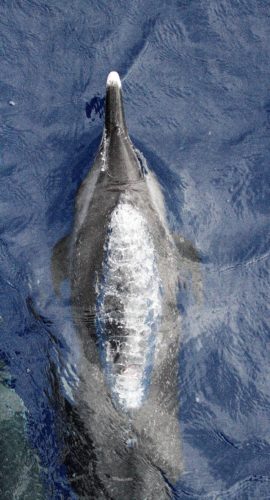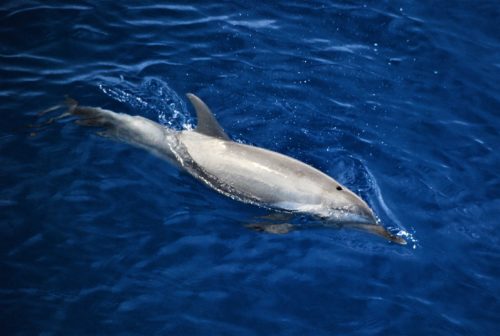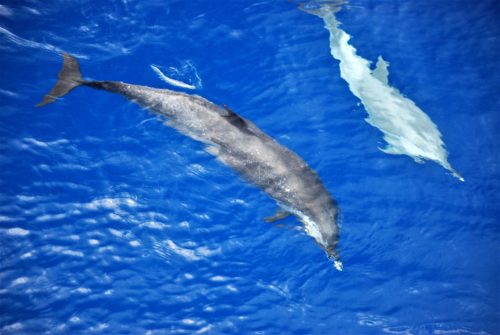June 14, 2017
Written by: Alexandria Hahn
Edited by: Amy Whitt

On Wednesday, we had a fairly large sighting comprised of dolphins. Through the “big eyes”, Danielle was seeing a group of bottlenose dolphins. She was able to confirm this because they were being very playful and spyhopping (bringing their heads up out of the water), so she got a great look at their bottle-shaped rostrums.
Not long after she spotted these bottlenose dolphins, some smaller dolphins began to make their way towards the bow of our vessel. They no doubt wanted to ride our bow waves, but, sadly, we were not moving at the moment and couldn’t start moving because of some of the other operations our science team was conducting. We could tell pretty quickly that they were not going to stay interested in our vessel if we were not moving, but they stuck around just long enough for us to get a good look at them. These dolphins were definitely not bottlenose dolphins because they were very small, and they had much longer and thinner rostrums. After seeing these features, we began to look at other markings in order to identify the species of dolphin. Right away, I noticed that some of the dolphins were different. There were actually at least two calves in the group that were significantly smaller than the others and so cute!
Another one of the dolphins was interestingly pale (see below) compared to the others, so Amy was sure to take plenty of pictures of that one to look at more later. This one dolphin may have been a hybrid of two different dolphin species. Aside from that one, all of the other dolphins had the “golf ball” nose (white tips on their rostrums). They also had prominent dark capes without a spinal blaze. Based on all of these features, we determined that they were pantropical spotted dolphins. Not all of the spotted dolphins came to our bow. Some were farther away near the bottlenose dolphins, so this meant that we had a mixed species sighting!


While swimming near the bow, the pantropical spotted dolphins were frequently jumping out of the water and making themselves known. It was quickly obvious to us that they wanted to play and that they definitely wanted our vessel to move. Because we could not get the go-ahead to move the vessel, not even a few knots, the dolphins got bored of us and decided to go out and play on their own. It was incredible to see how smart these animals are to know that boats make waves that they can play in.

While swimming away from us, they continued to be rowdy, leaping out of the water and spyhopping to take a look around. We were all sad that they didn’t want to stay close to us longer, but they were still amazing to watch from a distance.
There were quite a few dolphins in this sighting, and it seemed that more subgroups kept joining the party the whole time they were playing. We kept our eyes on them for 15-20 minutes after they moved away from the vessel since they seemed to be staying in the area. After that, they just sort of disappeared into the distance.
Everyone was able to get great photos of the pantropical spotted dolphins, and it was a great time for me to share videos on snapchat in real time so that my friends and family could see how amazing the work I am doing is. The videos got great responses, and gave me opportunities to educate people about different dolphin species. When responding to my friends and family, I referred to the animals not just as “dolphins” but “pantropical spotted dolphins” so that they might get interested and look them up on the internet. Overall, that was the third occurrence of dolphins coming up to our bow on this expedition, but they never became less exciting.
***This blog article is part of our LADC-GEMM 2017 Survey blog series. Check out more articles in this series here, on the LADC-GEMM website, and on Alexandria Hahn’s blog. Also, be sure to “Like” the new LADC-GEMM Facebook page!***

